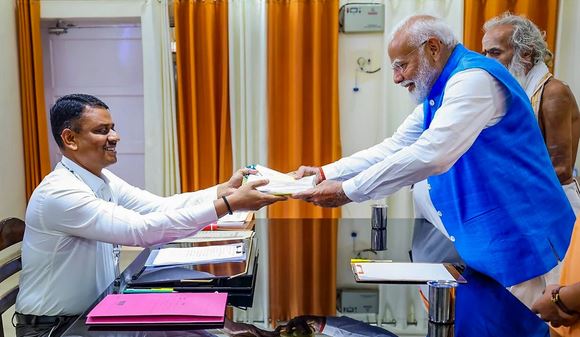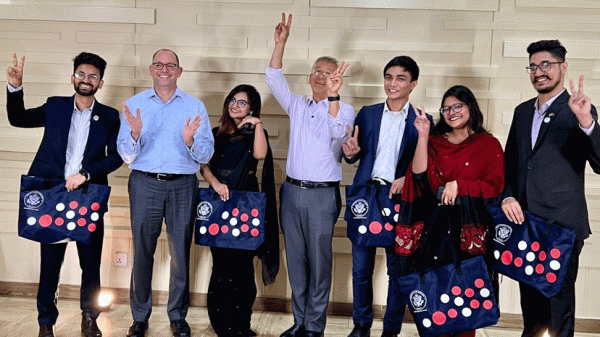‘Bionic woman’ is first to have robotic limb merged with bone — and controlled with her mind

Shawdesh desk:
A patient dubbed “the real bionic woman” has become the first to receive a robotic limb fused with both her nervous and skeletal systems.
Karin, a 50-year-old woman from Sweden, had the intelligent artificial limb fitted a few years ago after losing her right hand in a farming accident more than 20 years ago.
She spent years dealing with excruciating phantom limb pain, and the existing conventional prosthetic limbs were uncomfortable and not great for everyday use.
“It felt like I constantly had my hand in a meat grinder, which created a high level of stress and I had to take high doses of various painkillers,” she told South West News Service.
A study, published Wednesday in Science Robotics, revealed she now can perform 80% of what she used to do with both hands and even feels some sensations in the artificial arm.
Researchers said that since it’s worked for three years now — Karin is able to turn doorknobs, cook meals and more everyday activities — it’s a sign it’s now “highly integrated” into her life.
“We’re still far away from Luke Skywalker’s hand,” lead researcher Dr. Max Ortiz-Catalan told CNN. “We’re still not close to all the functions of a biological hand, but we definitely made a considerable step forward.”
To develop Karin’s new bionic limb, a multidisciplinary group of engineers and surgeons from Sweden, Australia and Italy created what they’re calling a revolution for those suffering limb loss, fusing surgery, implants and AI.
Professor Rickard Brånemark, a research affiliate at the Massachusetts Institute of Technology (MIT) and associate professor at Gothenburg University in Sweden, headed the study, which began in 2019 detailing the first-ever permanent neuromusculoskeletal implant.
“By combining osseointegration with reconstructive surgery, implanted electrodes, and AI, we can restore human function in an unprecedented way,” Brånemark said. “The ultimate goal is to make a more natural way to replace a lost limb, to improve the quality of life for people with amputations.”
Osseointegration, the process that connects bones to the electrodes implanted in the nerves and muscles, was paired with a surgery called targeted muscle reinnervation (TMR), which re-arranges nerves and muscles in the residual limb and links them to the remaining muscles.
When attached to the metal implant, her new prosthetic arm — called the Mia Hand and developed by the Italian company Prensilia — translates the movements of the bone and nervous system into the device, which can be taken off if Karin chooses.
All of this working together mimics the process of the brain sending messages to the body to move — so, thinking about moving activates the nerves, and the sensor implant picks that activity up and facilitates moving the artificial arm.
Since the nerves are working successfully, the study detailed that Karin now has a limited sense of touch through the bionic hand.
Christian Cipriani, a professor at the Scuola Superiore Sant’Anna in Pisa, Italy, said the process is so noteworthy because it’s a “consolidation of state-of-art prosthetic and robotic technologies available in our institutions, that may have a terrific impact on people’s lives.”
The research team believes that the results can help amputees — as it did for Karin, who said everyday life has gotten easier after she got surgery in December 2018 and started using the arm in the middle of 2019.
“Karin was the first person with below-elbow amputation who received this new concept of a highly integrated bionic hand that can be used independently and reliably in daily life,” Ortiz-Catalan, head of neural prosthetics research at the Bionics Institute in Australia and founder of the Center for Bionics and Pain Research in Sweden, said in a statement.
Amputees often choose not to get sophisticated, commercially available artificial limbs because attachment can be painful and uncomfortable, and because they’ll have limited control over the limb.
Brånemark, who has been working with osseointegration since it was first introduced to humans, explained “the below elbow amputation level has particular challenges.”
“The level of functionality achieved marks an important milestone for the field of advanced extremity reconstructions as a whole,” Brånemark said.
“The acceptance of the prosthesis is critical for its successful use. Besides technical performance, Prensilia struggled to develop a hand that could be fully customizable aesthetically,” Dr. Francesco Clemente, managing director of Prensilia, said.
“Mia Hand was born to be shown and not hidden. We wanted the users to be proud of what they are, rather than ashamed of what was lost.”
Karin says her bionic arm has been “life-changing,” reducing her phantom pain and allowing her to regain independence and participate in everyday life.
“I now have better control over my prosthesis, but above all, my pain has decreased,” she said. “Today, I need much less medication. For me, this research has meant a lot, as it has given me a better life.”
“The fact that she has been able to use her prosthesis comfortably and effectively in daily activities for years is a promising testament to the potential life-changing capabilities of this novel technology for individuals facing limb loss,” Ortiz Catalan said.























Leave a Reply